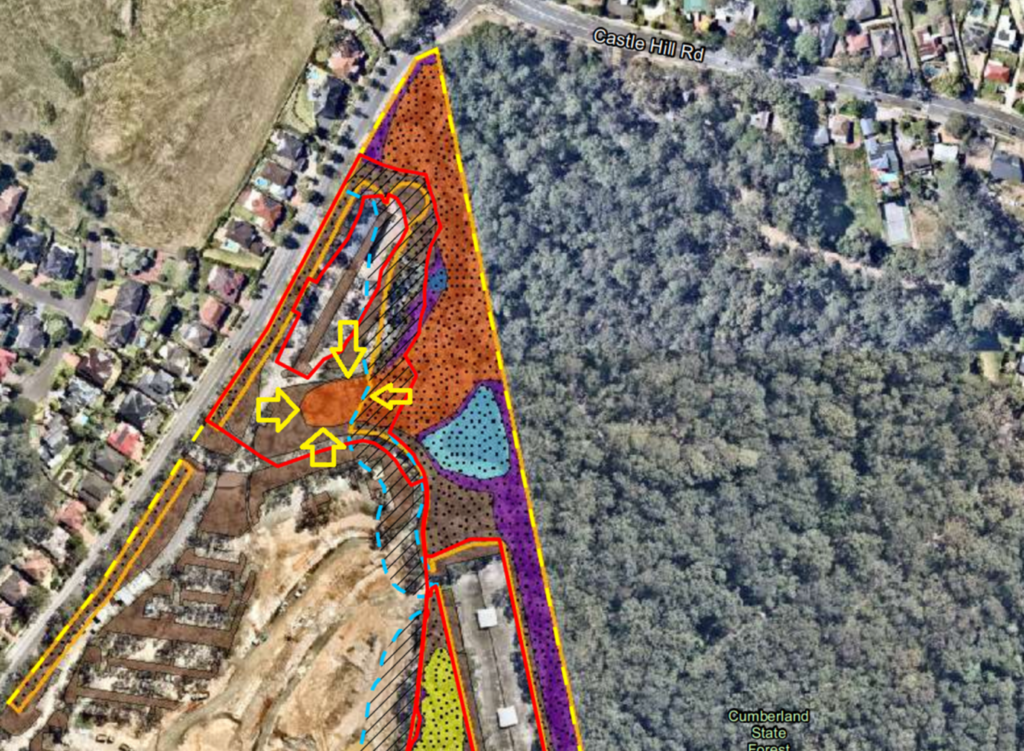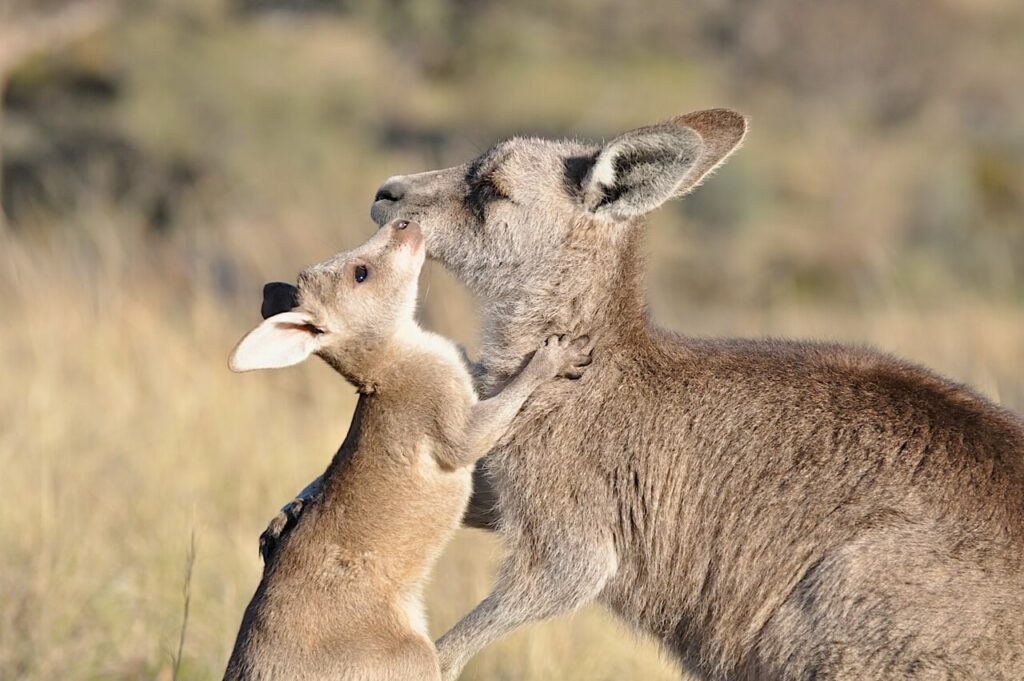
We start with a February 2024 update from Sydney wildlife advocate Katrina Emmett, as Mirvac’s bulldozers remove more of a forest — remnant native vegetation and precious habitat for wildlife still hanging on in the city. This is happening on the ex-IBM site at 55 Coonara Avenue West Pennant Hills now proposed for housing development. At the end of this update, is advice on how concerned citizens can still make their voices heard. An earlier report on this threat to urban wildlife, (scroll down below the update) has more detail on the species being threatened
Here is their story and a call for reader action to contact Hills Shire and Hornsby Councils and ask them to abide by minimal wildlife protection standards in planning and development consents.
We start with a February 2024 update from Katrina as Mirvac’s bulldozers remove more of a forest — remnant native vegetation and precious habitat for wildlife still hanging on in the city. This is happening on the ex-IBM site at 55 Coonara Avenue West Pennant Hills now proposed for housing development. At the end see how concerned citizens can still make their voices heard. The earlier story below has more detail on the species being threatened
As a result of this second referral, the removal of Blue Gums on this site have been declared to be a ‘controlled action’ – which is sadly a little late for all those that have already been cleared. There is an opportunity in late February, early March to ensure that no more Blue Gums are impacted for the building of houses in this precious forest which many believe should never have been rezoned for residential purposes.

The provision of just a few extra houses is not a good enough reason to remove a ‘critically endangered’ forest. To add insult to injury, the developer has announced their intention to call this residential area, once completed, ‘High Forest’ which to many seems in very poor taste.
Tell the minister this impact is avoidable.
Community voices do make a difference and the support of AWPC members and others along with many other community & conservation groups has already ensured that an area at the southern end of this site has not been cleared for this housing project. We hope this developer will be deterred from ever trying to build on rare and endangered forests in the future. We can but hope.
Blue Gum High Forest lives nowhere else on this planet except here in the Sydney region and we must protect it.
PICTURED ABOVE: Powerful Owl, cr Greg Sharkey (CC-SA 4.0); Feathertail Glider, cr Tony Rees (CC-SA 4.0); Sugar Glider, cr Patrick Kavanagh (CC-SA 2.0). Blue Gum Forest backdrop, cr Peter Woodard (CC-SA 4.0). Source: Wikimedia.
There is increasing pressure on urban forests with many developers hungry to build and with development being ‘fast-tracked’ as a result of the pandemic. Across NSW, residents are witnessing the loss of remnant forests, the last bastions of ‘green’ in our towns and the last refuges for our native animals.
As a wildlife rescuer, it is particularly heartbreaking when we see the fall-out from this habitat loss …
there is a direct correlation between loss of trees and animals reported to us in distress. Furthermore, what is more worrying is the lack of protection that is evidenced on development sites. They are bulldozing our wildlife yet all native wildlife in NSW is nominally protected by law.

It has become apparent that there is a problem. An exemption in the Biodiversity Conservation Act offers a ‘defence’ against harming a protected native animal (which is an ‘offence’ for everyone else in NSW) and that defence is if you have ‘development consent’.
That’s where a Fauna Management Plan (FMP) comes in. It’s not a requirement for all development sites, but it is sometimes requested as a last line of protection for our wildlife when development is impacting on areas where there is known to be high density of wildlife.

However, you will be surprised to find out that there are no standards for writing one, and no requirement for them to follow any codes of practice. They are written by ecologists who are employed by developers and approved by local councils.
There are standards for many operations on development sites — heritage, waste, soil contamination — but no standards for what happens to the birds, mammals, reptiles and amphibians that are living on the site. These FMPs vary greatly in quality and many are failing our wildlife and not giving them enough protection.
This issue has recently come to the attention of our MPs and councillors and questions were recently asked by the Hon. Mark Pearson of AJP in Parliament. He questioned why there are no minimum standards, and why there is no oversight of FMP’s apart from at local council level.
Someone must take responsibility for the injuries and deaths that are occurring when wildlife habitat is being cleared for development. Wildlife rescuers and vets follow stringent protocols and NSW Codes of Practice for every animal that they interact with — it is a condition of their licence.
Yet, on development sites, these same animal welfare standards do not apply.
On September 14th in Hornsby Council, a Motion was put forward by Greens Councillor Tania Salitra to take this issue forward to the Local Government NSW Conference so that it could be voted on by all councils in NSW and put forward to the State Government for attention.
This was subsequent to Cate Faehrmann, Greens MP, putting forward a Motion in Legislative Council back in July to introduce standards for Fauna Management Plans, and to put in place protocols for protecting our wildlife on all development sites. The Motion was blocked.
On October 11th, Greens Councillor Dr Mila Kasby (a veterinarian by trade) also put forward a Motion to ask Hills Shire Council to lobby State Government for better animal welfare standards for wildlife on development sites and for FMP’s. This was also blocked (8 Liberal votes vs 1 Green + 3 Labor).
Now, at a local council level, we are hoping this issue can be raised again and not so easily dismissed. The volume is rising and we must ensure greater protections are put in place. It is not ok for our animals to be crushed, dropped, displaced and to starve because of development happening around them. There must be integrity and there must be standards applied. Animal welfare must be a priority for all development impacting our precious native animals.
There is strong community opposition to the loss of bush and tree canopy at the moment.
The issue of formalising a mountain biking trail network in Westleigh is raising the question of whether this should be considered when there are Critically Endangered Ecological communities being impacted, and in turn, impacting on the wildlife that it supports.
NSW Government is also proposing to formalise networks of MBT trails in our National Parks. At Fred Caterson Reserve in Castle Hill, local council is proposing the removal of over 600 mature trees for sporting fields — with artificial turf at that.
It’s happening everywhere, all around us, and we must ensure our wildlife is given the utmost protection possible when development is removing their homes from under them.
For that very reason, we must keep fighting for our wildlife. We are their only voice.
Please write to Hills Shire Council and let them know that Mirvac must do a further Fauna Management Plan for the next 3 DA’s they are seeking approval for that will be removing over 1,800 trees (DA’s 859,860,861/2022/JP) and against the development at Fred Caterson Reserve. Do the same for Hornsby Council — write to the councillors and let them know your concerns on how the wildlife will be impacted when the endangered forest at Westleigh Park is not protected from mountain biking trails in the forest.
Katrina reports: We have just had some good news — the Fauna Management Plan Motion put forward by Hornsby Council has just PASSED today at the LGNSW Conference — and it passed unanimously! Which means no councillors voted against these reforms.